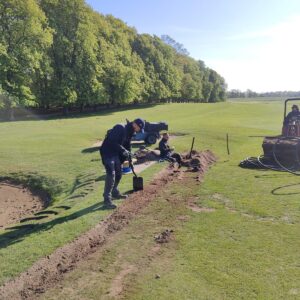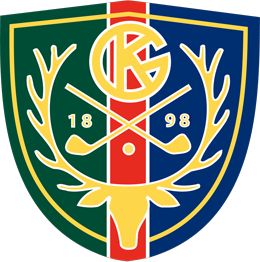The field is open for play.
The course
Course status
Course work

Construction work at the 11th green
On Wednesday 29th and Thursday 30th October, the greenkeepers will be installing greens irrigation at the 11th green. This means that play will be
Facilities
18 hole course
Open. Plays as Winter Course.
Par 3 course
Winter course closed. Also applies to shortgame area.
Putting & Driving Green
The putting green and driving green are closed during the winter.
Driving Range
We have reached the time of year when the large tee on the driving range is closed for the winter. It is still possible to practice, but it is done in front of the closed tee. As a result, a maximum of 175 meters can be hit.
- Driving Range with targets
- Short game practice area with bunker and green
- Training bunker with green
- Small and large putting green
- Trackman & Videolab
- Puttinglab
- Demo equipment for fitting
Course guide

FACTS
Pair: 3
Handicap: 15

FACTS
Pairs: 4
Handicap: 13

FACTS
Pairs: 4
Handicap: 11

FACTS
Pairs: 5
Handicap: 1

FACTS
Pairs: 4
Handicap: 3

FACTS
Pairs: 4
Handicap: 7

FACTS
Pairs: 4
Handicap: 5

FACTS
Pairs: 4
Handicap: 9

FACTS
Pairs: 4
Handicap: 17

FACTS
Pairs: 4
Handicap: 10

FACTS
Pairs: 5
Handicap: 2

FACTS
Pair: 3
Handicap: 16

FACTS
Pairs: 4
Handicap: 8

FACTS
Pairs: 4
Handicap: 12

FACTS
Pairs: 4
Handicap: 6

FACTS
Pair: 3
Handicap: 18

FACTS
Pairs: 5
Handicap: 4

FACTS
Pair: 3
Handicap: 14

Local rules for Copenhagen Golf Club
Distance markings on tees are measured from the center of the tee to the center of the green.
Distance markings on the fairway are measured to the center of the green.
Yellow boards/poles: Penalty area
Red boards/poles: Penalty area
Bruises: Area under repair
Blue poles with GREEN top: Area under repair with no play allowed
The fairway edge of Rådvadsvej, Chausseen and Hjortekærsvej, as well as the fence behind the 18th green, indicate the out of bounds limit.
When a player's ball has not been found, or it is a fact or virtually certain that it is out of bounds, the player may continue as follows rather than playing from the previous spot.
With a penalty of two strokes, the player may take relief by dropping the original ball or another ball in this relief area (see Rule 14.3):
Two estimated reference points:
Ball Reference Point: The point where the original ball is estimated to be:
To have come to lie still on the field, or
Most recently, the pitch crossed the outer boundary on its way out of bounds.
Fairway Reference Point: The point on the fairway of the hole being played that is closest to
the ball reference point, but no closer to the hole than this.
In this Local Rule, “fairway” means any area of grass in the general area that is mowed to fairway height or lower.
If a ball is deemed to be lost on the course, or last crossed the outer boundary of the course before the beginning of the fairway, the fairway reference point may be a grass path or teeing ground for the hole being played that is mowed to fairway height or lower.
Size of the relief area based on reference points:
Anywhere between:
A line from the hole through the ball reference point (and within two club-lengths outside that line), and
A line from the hole through the fairway reference point (and within two club lengths to the fairway side of that line).
However, with these restrictions, the limits for the location of the relief area:
Must be in the general area and
Must not be closer to the hole than the ball reference point.
Once the player has put his ball into play under this Local Rule, the original ball that was lost or out of bounds is no longer in play and must not be played.
This applies even if the ball is found on the course before the end of the three-minute search time (see Rule 6.3b).
But the player must not take this relief option for the original ball when:
It is a fact or virtually certain that the ball has come to rest in a penalty area, or
The player has played a provisional ball from a previous spot (see Rule 18.3), or
The player has declared the ball unplayable (see Rule 19).
A player may take this relief option for a provisional ball that has not been found or that is, as a matter of fact or virtually certain, out of bounds.
Penalty for playing a ball from a wrong place in breach of a local rule: General penalty under Rule 14.7a.
Note:
This local rule does not apply in tournaments unless stated in the conditions for the individual tournament, which are set by the Committee.
Fences around individual trees and fixed stones with course markings are non-removable obstructions. Relief under Rule 16.1.
All paths are integral parts of the course.
Correct impact marks and lay turfs in place.
Stone marked with yellow/black mark indicates 150 meters to the middle of the green.
The utmost consideration must be shown towards the Deer Park's audience and deer.
Penalty for violation of local rules: Match play: loss of hole – stroke play: 2 penalty strokes
A unique and historic golf course next to the King's Hunting Lodge
The course is shaped after the natural contours of the Eremitagesletten and the high ridges of former agricultural fields, which characterize the fairways and greens. On the open plain, the biggest challenges are the wind, the rough, the strategically placed bunkers and the fine details of the greens.
A good round requires precision, patience and touch around the greens. The course is located in a corner of the Deer Park with large, old oaks and an impressive chestnut avenue at the edge of the forest. Most holes have views of the Hermitage Palace, and on the large plain red deer and fallow deer often graze just a few meters from the tees.
The course bears the distinct mark of having been designed in the golden age of golf architecture and is a very fine example of an open parkland course. It appears as a traditional golf course with fast and firm greens, very natural-looking fairways and bunkers and only relatively few trees in play; however, between the tee and the green on the 18th hole there are two large chestnut trees, which make the final hole very scenic and for most, even a very big challenge (par 3). Many golfers have over the years either won or lost a match here.
The current course was built in 1928, designed by a now unknown Scottish course architect, and a few years ago it was redesigned and updated, also by a Scot, Tom Mackenzie, who over the years has designed and improved a large number of courses around the world.
The course is maintained completely green according to all the latest regulations regarding golf course maintenance – i.e. with an absolute minimum consumption of pesticides. With this long-term form of care, we can not only comply with all applicable rules and conventions – but also create soil conditions that ensure that we can support the growth of the long-term grass species (red fescue and common fescue), which should make up as much of the playing area as possible.
If you want to play golf on one of the most beautifully situated golf courses on Zealand, then Copenhagen Golf Club in Dyrehaven is the right place to go.
The vision for the track:
Copenhagen Golf Club in Dyrehaven with the golf course's unique and historical
location on the Eremitage plain creates a fantastic setting for the course with
the surroundings that are in harmony with nature and also under UNESCO's
protection. Including this natural experience in your golf round adds an extra
dimension to the game for most people, but we should not only be proud of the pitch's
surroundings, but also what it can achieve. In other words, we would also like a
golf course with a high quality of care that is ambitious towards development goals and
performance.
The design of the course should cater to a wide range of handicap levels where it
Aesthetics as well as game strategy must be paramount for the experience you get.
has at games on the field.
The golf course must be constantly developed and maintained so that potential opportunities
utilized to raise game quality, design and standards to a higher level.
The care must be sustainable and have the least possible impact on nature, while at the same time
the level of care and standard always aim for a high level where the visual impression
has a high ethical expression and a quality that matches the beautiful surroundings, cf.
Course Management Policy Document (CMPD).
Mission and values for the course:
The track personnel are the ones who must deliver the work effort required by
the members based on the funds and resources that are allocated and thereby
perform the tasks with professional quality and resource utilization for
to achieve goals that we can all be proud of.
The course should be open all year round as much as possible, which is why the maintenance is planned and
are prioritized so that the level of care is geared towards the longest possible playing season, spring, summer,
autumn and a winter season with the introduction of minor restrictions in order to
limit overloading of the system.
Care is planned and prioritized so that the level of care takes into account major game days.
and matches, but in addition, high quality must always be strived for every day.
